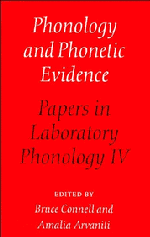Book contents
- Frontmatter
- Contents
- List of contributors
- Acknowledgments
- 1 Introduction
- I Features and Perception
- II Prosody
- 8 Stress shift: do speakers do it or do listeners hear it?
- 9 The phonology and phonetics of the Rhythm Rule
- 10 The importance of phonological transcription in empirical approaches to “stress shift” versus “early accent”: comments on Grabe and Warren, and Vogel, Bunnell, and Hoskins
- 11 Perceptual evidence for the mora in Japanese
- 12 On blending and the mora: comments on Kubozono
- 13 Toward a theory of phonological and phonetic timing: evidence from Bantu
- 14 On phonetic evidence for the phonological mora: comments on Hubbard
- III Articulatory Organization
- Subject index
- Index of names
- Index of languages
8 - Stress shift: do speakers do it or do listeners hear it?
Published online by Cambridge University Press: 03 May 2011
- Frontmatter
- Contents
- List of contributors
- Acknowledgments
- 1 Introduction
- I Features and Perception
- II Prosody
- 8 Stress shift: do speakers do it or do listeners hear it?
- 9 The phonology and phonetics of the Rhythm Rule
- 10 The importance of phonological transcription in empirical approaches to “stress shift” versus “early accent”: comments on Grabe and Warren, and Vogel, Bunnell, and Hoskins
- 11 Perceptual evidence for the mora in Japanese
- 12 On blending and the mora: comments on Kubozono
- 13 Toward a theory of phonological and phonetic timing: evidence from Bantu
- 14 On phonetic evidence for the phonological mora: comments on Hubbard
- III Articulatory Organization
- Subject index
- Index of names
- Index of languages
Summary
Introduction
Metrical Phonology has given considerable attention to stress shift of the “thirteen men” type. This phenomenon is said to apply when a word such as thirtéen, with two full vowels and the strongest prominence on the last stressable syllable in citation form, is closely followed by a further strong syllable such as men In such cases, the stresses “clash”, and the prominence pattern of thirtéen is reversed, producing the sequence thírteen mén
This paper presents an experimental investigation of stress shift sequences' in Southern British English, focusing on three aspects of our research. First, we test predictions derived from standard assumptions made by Metrical Phonology (e.g. Hogg & McCully, 1987) concerning the application of stress shift in read connected speech. Second, we investigate acoustic and perceptual evidence for stress shift. Finally, we discuss an alternative account of stress shift which does not involve stress clashes.
Background
In providing accounts for various rhythmical structures in continuous speech, Metrical Phonology has given considerable attention to stress shift (Liberman & Prince, 1977; Kiparsky, 1979; Selkirk, 1981, 1984; Hayes, 1984; Giegerich, 1985; Nespor & Vogel, 1989; Hogg & McCully, 1987; Gussenhoven, 1991). One notion that has been used in the description of stress shift in English phonology is eurhythmy (e.g. Selkirk, 1984; Prince, 1983), i.e., a general tendency towards a particular spacing of stressed syllables so that utterances exhibit a preferred periodicity. In English, this preference is reflected in a tendency for stressed and unstressed syllables to alternate.
- Type
- Chapter
- Information
- Phonology and Phonetic EvidencePapers in Laboratory Phonology IV, pp. 95 - 110Publisher: Cambridge University PressPrint publication year: 1995
- 14
- Cited by



